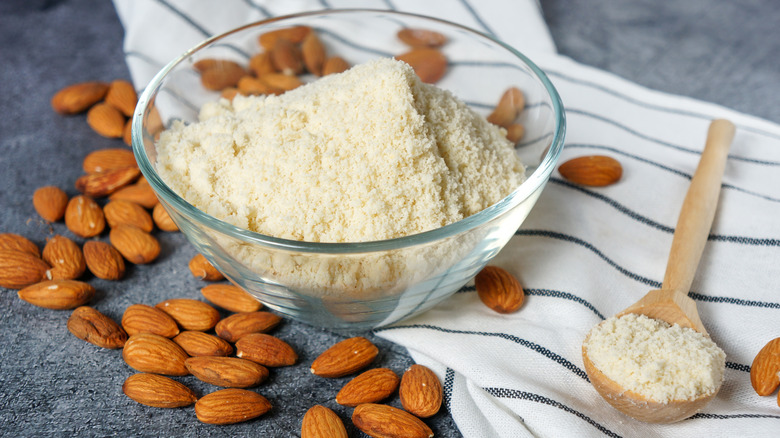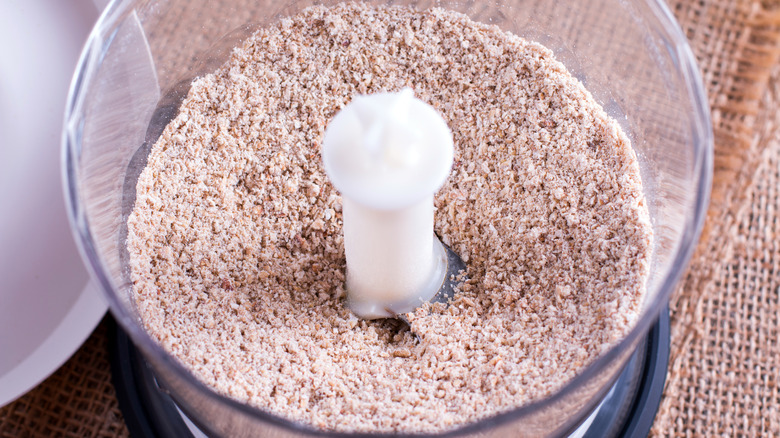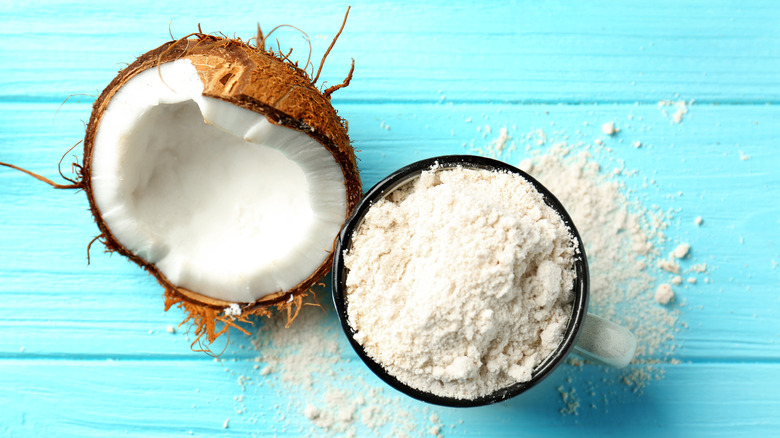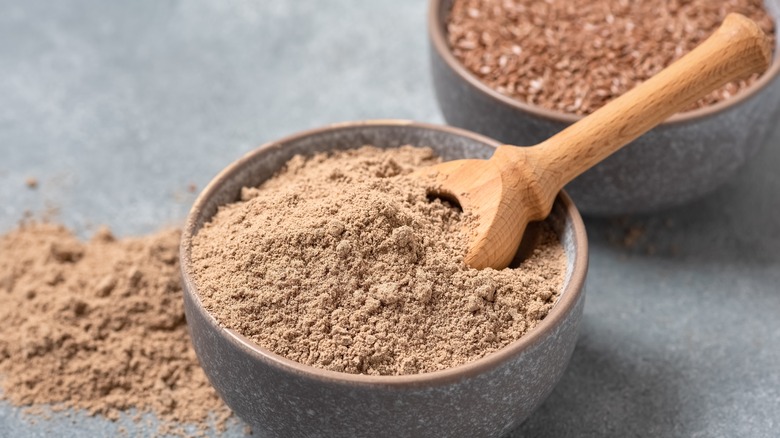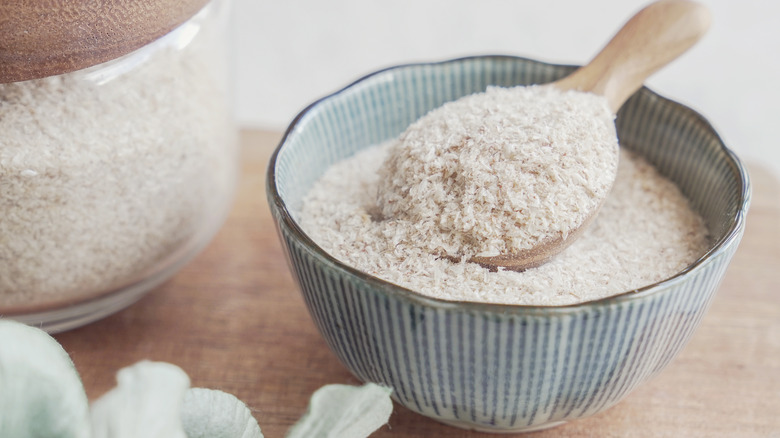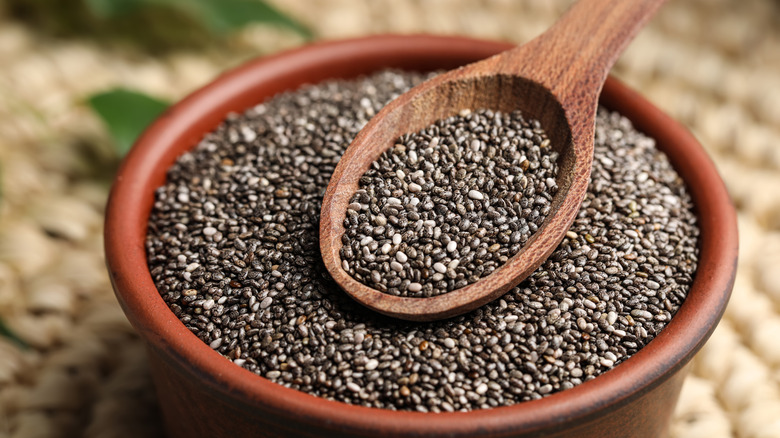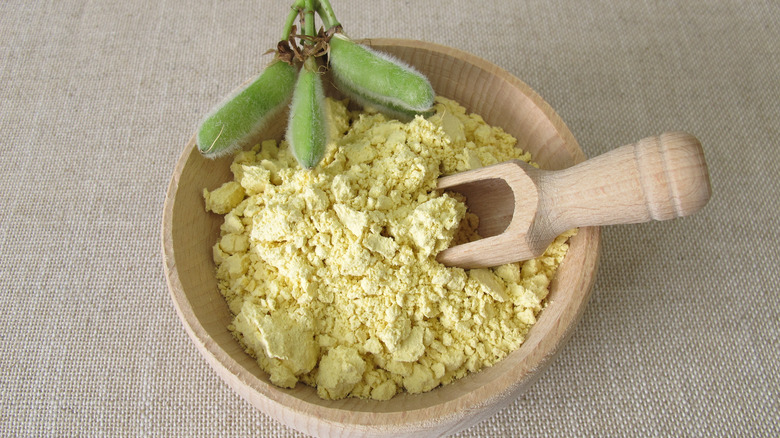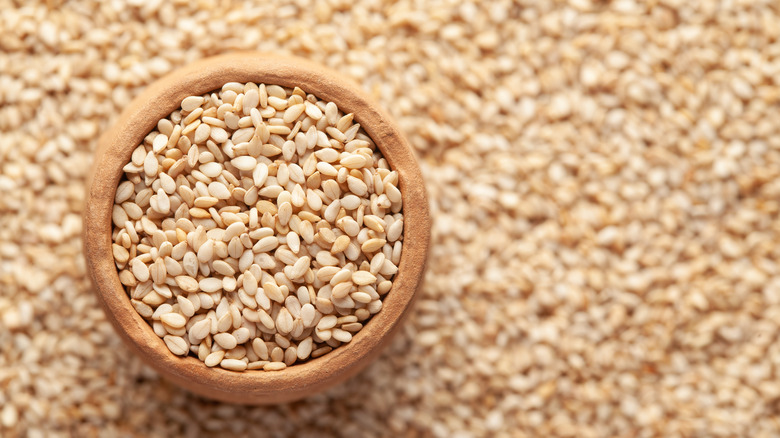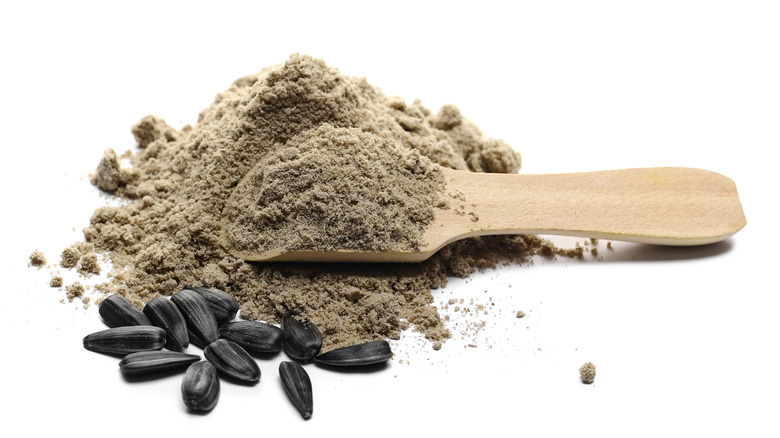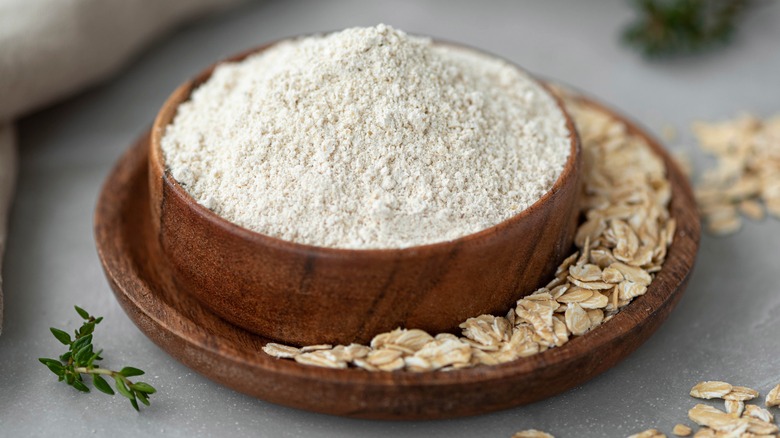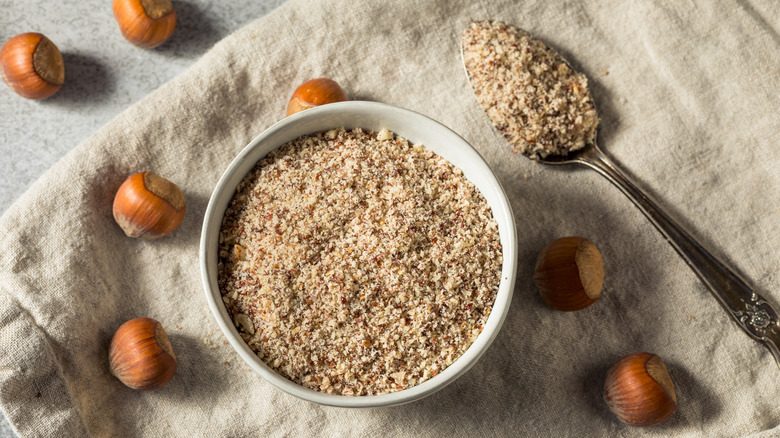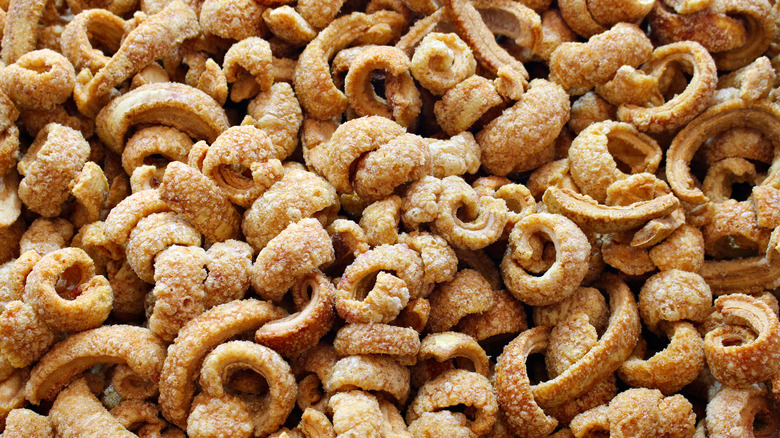The Best Keto Alternatives For Wheat Flour
Following a keto diet requires adjusting classic recipes in order to satisfy your daily macronutrient targets. With an emphasis on high fat, protein, and minimal carbohydrate intake (per Healthline), keto regimens may be a far cry from what you're used to. Loaves of white bread, pillowy cookies, and doughy pizzas are nowhere to be seen. Nonetheless, there are many inventive ways to tweak your favorite recipes to incorporate ingredients suitable for a keto diet.
Standard wheat flour (white or whole-grain) is the source of some of the most popular starchy goods. SF Gate describes its carbohydrate content breakdown, which consists primarily of starch and small amounts of sugar and fiber. The outlet highlights that dietary fiber is not digested, which is the basis behind the concept of net carbs. Many keto dieters count their carb intake by subtracting grams of fiber from grams of total carbohydrates (via Keto Mojo).
That's why the best wheat flour alternatives on a keto diet are high in fats and fiber to maintain an adequate balance of macronutrients. So, read on to discover our top picks for all your flour-based applications — yes, that also includes cookies and cake!
Almond flour
You might be most accustomed to eating them by the handful, but almonds actually grind up into a fine powder that can be used in a wide range of baked goods. The flour experts at Bob's Red Mill outline the production process, which entails blanching almonds to remove the skins before milling them into a flour-like consistency. While the result doesn't taste precisely like almonds, this flour has a rich and nutty flavor profile.
Almond flour doesn't behave exactly like wheat flour, so if you're trying to use it as a substitute, you're best off starting with about a quarter of the amount and completing the recipe with another low-carb option, according to Bob's Red Mill. Ultimately, your best bet is to choose recipes designed for almond flour, as they will have all the proper proportions.
According to Blue Diamond Almonds' cookbook about almond flour, additional binders like egg whites are necessary to thicken batters since almond flour contains no gluten. Similarly, since less liquid is soaked up, a larger flour volume is typically required to avoid overly wet dough. Sweet and salty recipes benefit from this nutty ingredient, and we can bet an ordinary coffee cake and breaded fish will also stand out.
Be sure to store almond flour tightly sealed in the refrigerator to prevent the fats from becoming rancid. Nutritionwise, 1 ounce of almond flour contains 14.2 grams of fat, 5.6 grams of carbohydrates, and 3 grams of fiber (via Healthline).
Almond meal
Not to be confused with almond flour, almond meal is a coarser ingredient that's great for many purposes. For starters, raw whole almonds are ground up with the skins still on, MasterClass explains. On the flip side, almond flour uses blanched, peeled almonds for a finer result. Since the skins are retained, almond meal has a grainier texture, distinguishing it from flour. Nonetheless, it is a great option for breading in place of standard bread crumbs. Much like most wheat flour alternatives, it's best to start by following recipes designed for almond meal since its coarser texture will produce different results.
Since no blanching or peeling is required, it's easy to make almond meal with a bag of whole raw almonds. Pop them in a food processor and pulse them until they reach the desired consistency. If you're not so inclined, almond meal is commonly sold in supermarkets in the baking aisle or with natural foods and nuts.
However, some brands have a different definition of almond meal. Bob's Red Mill offers two almond meal products — one made from blanched almonds and the other with the skin — but remarks that they behave the same in the kitchen. However, remember that ordinary almond meal with intact skins provides more fiber than almond flour, reducing your net carb intake. Otherwise, Healthline reports that the two are nearly identical nutritionally, apart from some of the antioxidant content from the skins.
Coconut flour
Coconuts sure have a lot of superpowers, from their electrolyte-rich water (per Mayo Clinic) to their creamy milk. Well, it's time to add coconut flour to your list of keto-friendly baking options. According to The Coconut Company, coconut meat is dried at a low temperature and then milled into a flour-like substance. Also, different processing methods entail removing some of the fat while others retain it. Consequently, the taste will either be mild or more noticeable. Given its sweet and savory flavor profile, coconut flour works in plenty of recipes like cookies, muffins, bread, soups, and curries.
Nutritionally, a 1-ounce portion counts 18 grams of carbs, 10 of which are fiber, 3 grams of fat, and 6 grams of protein (via Healthline). While the carb count might appear high, coconut flour is incredibly absorbent and requires a large amount of liquid or eggs. Therefore, you typically need only a quarter cup of the stuff for each cup of wheat flour.
Many bakers successfully pair almond and coconut flour for the perfect balance of flavor and texture. Since it behaves differently from other baking flours, this is definitely a case of sticking to a recipe until you get a feel for the results. Also, sieve the flour or whisk it well to avoid lumps in the final product.
Flaxseed meal
Tiny flaxseeds might look like long dark brown or golden sesame seeds, but they offer a very different result. In order to benefit from the seeds' rich omega-3 fatty acid content, it's necessary to break down the outer shell by grinding the seeds into a meal (via Mayo Clinic). You can buy the seeds already milled or do it yourself to guarantee freshness — either way, you're best off storing them sealed in the fridge or freezer.
Aside from 12 grams of healthy fats, a 1-ounce serving of flaxseed meal also contains 5.2 grams of protein and 8.2 grams of carbs, of which 7.8 are fiber (via Livestrong). If you're doing the math, the net carb count is a meager 0.4 grams, well in line with any keto regimen.
There are many ways to incorporate flaxseed meal into your daily diet, such as adding a tablespoon to smoothies, cereal, and yogurt, using it in baked goods, or swapping it in place of bread crumbs. The flavor isn't overpowering and borders on nutty, making it an excellent complement to many dishes. Interestingly, ground flaxseed is an excellent substitute for eggs when mixed with water — three parts water to one part flaxseed meal (via Flax Council of Canada).
Psyllium husk
Its name sure is a mouthful, but don't let that stop you from adding a few spoonfuls of psyllium husk to your next baked creation. First, this stuff packs in plenty of fiber and is commonly used as a laxative, according to Mind Body Green. A 1-ounce serving contains 24.9 grams of carbs, yet a mere 3.1 grams of net carbs thanks to the high fiber content. However, psyllium husks have zero fat, which makes pairing it with high-fat flour a good option for your keto diet.
Thankfully, it's possible to incorporate it into recipes without unwanted side effects. In fact, you'll benefit from its ability to stabilize blood sugar levels, ultimately reducing food cravings. Psyllium husks come whole or powdered, the latter more akin to flour. But don't expect to use it exactly like you would wheat flour since its density and capacity to absorb liquid affect results (via Low Carb Yum). Nonetheless, since the taste is mild, you won't notice much on the flavor front.
Stick to recipes that use this ingredient and combine it with other low-carb flours like coconut or almond for success. According to Mind Body Green, much like flaxseed meal, psyllium husks can be mixed with water (¼ cup of water to ½ teaspoon of powder) to replace eggs in vegan baking. Try psyllium husks in your next baked bread, buns, pancakes, and pizza doughs.
Chia flour
Chia seeds are not only the source of the gel-like texture of chia puddings but can also be milled into a highly nutritious flour. As The Chia Co. points out, the seeds have no flavor, making them easy to sneak into many recipes. Whether you mix the flour into the brownie batter, bread dough, or cookies, the result is a nutrition boost. Nutritionally, 1 ounce contains 2.5 grams of fats (primarily omega-3s), 7 grams of protein, and 15.9 grams of carbs, of which 15.7 are fiber (via Eat This Much). Collectively that's only 0.2 grams of net carbs per ounce — talk about a keto dream.
To get chia flour, buy the seeds whole and grind them yourself or purchase the flour premade. You'll want to store it in an airtight container for maximum freshness. Chia flour is another good option for imitating the consistency of eggs in vegan recipes; mix ½ cup of cold water with 2 tablespoons of chia flour and wait 30 minutes (via Nuts.com). Given this characteristic, you can swap chia flour for bread crumbs or other high-carb binders. According to Nuts.com, since the flour produces a thick mass, it's best to use a one-to-three ratio of chia flour together with another option like almond flour if you're experimenting. As always, until you master how it behaves, recipes designed for chia flour are your safest bet.
Lupin flour
While it might not be among your standard grocery store purchases, lupin flour is an excellent choice if you're looking for a keto alternative to wheat flour. Made with lupin beans (similar to white beans), Perfect Keto highlights it as a low-carb option that can be used solo or with other flours for baking. Depending on the brand, the taste may be slightly bitter, so it's worth incorporating into a recipe with stronger flavors or combining it with more neutral flours to minimize the effect.
According to Perfect Keto, an ounce (about ¼ cup) of lupin flour is incredibly high in fiber, with 11 grams and only 1 gram of net carbs. Additionally, it counts 12 grams of protein and 2 grams of fat. While it is on the lower end of the fat spectrum, as long as you favor other high-fat ingredients in your recipe, your macro profile should be in balance.
Try using lupin flour in sweet and savory recipes that require starchy flour, or blend it right into smoothies for extra thickness (via The Lupin Co.). The final result will be light, airy, and similar to wheat flour. If you're looking for ways to increase your protein intake, baking with this legume flour is the perfect answer.
Sesame flour
You've undoubtedly already come across sesame seeds (perhaps coating a starchy bagel in your pre-keto days). However, sesame flour is another ingredient entirely. Given its powdery consistency, it doesn't work as a one-to-one substitute with wheat flour, and Low Carb Yum recommends starting with a quarter of the volume and completing the balance with an alternate keto flour.
Nutritionally, sesame flour is an easy keto option, with around 10 grams of fat, 8.7 grams of protein, and 7.5 grams of carbs in 1 ounce (via Carb Manager). According to My Sweet Keto, some packaged versions are defatted, reducing the fat content, although it remains within keto parameters. If you're making sesame flour yourself, you'll be able to benefit from the healthy fats, although you might have to adjust the other sources of fat in a recipe to balance out the high-oil content.
The taste is undoubtedly reminiscent of sesame seeds, so make sure it works with the overall flavor profile of your recipe. For the same reason, it shines in baked goods like cookies, pancakes, sweet and savory loaves, and cake. It's especially tasty if you're looking for nutty flavors minus the nuts. Or, enhance a breaded meat or vegetable recipe with a coating of sesame flour.
Sunflower seed flour
Easy to grind yourself (hulled, of course) or purchased in specialty grocery stores and bulk food stores, sunflower seed flour is a suitable choice for a keto diet. A 1-ounce serving contains 16 grams of fat, 5 grams of protein, and only 3 grams of net carbs (via My Sweet Keto). Although the fats are predominantly omega-6 fatty acids which should be consumed in moderation, as long as you eat enough omega-3s, it isn't an issue.
My Sweet Keto highlights that sunflower seed flour is a much cheaper alternative to wheat flour than almond or coconut flour, undoubtedly, a valuable quality. Another bonus is that people with nut allergies can safely enjoy it. Feel free to experiment by swapping all-purpose or almond flour for equal parts sunflower seed flour (via Wellness Mama). Thanks to its mildly nutty and ever so lightly sweet natural flavor, this is the perfect option to elevate a simple batch of cookies or loaf of bread without getting in the way of your keto diet.
Oat fiber
Most people have consumed oats in one form or another, but oat fiber is a different entity. Unlike the kind you eat in oatmeal which is made with the center of the plant, aka the groat, oat fiber comes from the shell (via Keto Connect). And contrary to its more popular counterpart, oat fiber consists entirely of insoluble fiber, which means that the net carb count is close to zero. More specifically, the exterior hull is ground into a powder similar to all-purpose flour.
Your best bet is pairing oat fiber with another keto alternative like almond flour. Otherwise, Keto Connect recommends using ¼ cup for each cup of all-purpose flour since it tends to absorb more liquid. Given its incredibly high fiber content, Grain Millers points out that oat fiber works well in conjunction with high-fat ingredients used in many keto recipes to produce a suitable texture. While some other keto flour options have distinctive flavors, oats are fairly commonplace and can easily complement the flavors in your baking.
Hazelnut flour
Much like almond flour, hazelnut flour comes in varying degrees of coarseness from powder to meal. However, the more delicate texture is a better substitute for all-purpose flour in recipes. If you love the flavor of hazelnuts, then this delicious keto alternative is an easy sell. With a subtly sweet, rich, and buttery flavor, hazelnut flour works equally well in sweet and savory recipes.
Since hazelnut flour is made from a nut, it lacks gluten and should be combined with another flour for optimal consistency. Depending on the density of the baked good, you'll want to use more or less hazelnut flour; chewier items like cookies can replace half the amount of all-purpose in recipes, whereas muffins or cakes should reduce the substitution to a third (via MasterClass). Meanwhile, chocolatey concoctions like brownies and fudgy cookies can handle plenty of hazelnut flour (think Nutella).
You can buy hazelnut flour already made, but if you are grinding it yourself, then go slowly to avoid making hazelnut butter (which wouldn't be the worst mistake, all things considered). To prevent this, many bakers add a small amount of sugar (or a keto sweetener, per Low Carb Yum). This flour substitute is great for keto baking, and a 1-ounce serving counts 17 grams of fat, 4 grams of protein, 5 grams of carbs, and 3 grams of fiber (via Eat This Much).
Pork rinds
Hear us out here — pork rinds (fried pork skin) can be an excellent keto alternative to wheat flour in specific applications. All you have to do is grind up dried pork rinds in a food processor or buy it already made (via Very Meaty). Depending on the grind's coarseness, they make a suitable substitution for bread crumbs or flour. Given that you're working with meat, pork rinds work best in savory recipes. Use them as a thickener or binder in meatloaf, patties, or as a coating for meat, fish, vegetables, and casseroles.
Since pork rinds are pure meat, Ruled.me highlights their zero carb count. The rest of the macronutrient profile is mainly fat (9.4 grams) and protein (18.4 grams) per ounce. If you're looking for a source of animal protein and fat that can double as a starch, pork rind flour is the obvious solution. It doesn't get any better!

